Abstract
1. Human alpha 1-acid glycoprotein (AAG), a plasma transport protein, has three main genetic variants. F1. S and A. Native commercial AAG (a mixture of almost equal proportions of these three variants) has been separated by chromatography into variants which correspond to the proteins of the two genes which code for AAG in humans: the A variant and a mixture of the F1 and S variants (60% F1 and 40% S). Their binding properties towards imipramine, warfarin and mifepristone were studied by equilibrium dialysis. 2. The F1S variant mixture strongly bound warfarin and mifepristone with an affinity of 1.89 and 2.06 x 10(6) l mol-1, respectively, but had a low affinity for imipramine. Conversely, the A variant strongly bound imipramine with an affinity of 0.98 x 10(6) l mol-1. The low degree of binding of warfarin and mifepristone to the A variant sample was explained by the presence of protein contaminants in this sample. These results indicate specific drug transport roles for each variant, with respect to its separate genetic origin. 3. Control binding experiments performed with (unfractionated) commercial AAG and with AAG isolated from individuals with either the F1/A or S/A phenotypes, agreed with these findings. The results for the binding of warfarin and mifepristone by the AAG samples were similar to those obtained with the F1S mixture: the mean high-affinity association constant of the AAG samples for each drug was of the same order as that of the F1S mixture: the decrease in the number of binding sites of the AAG samples, as compared with the F1S mixture, was explained by the smaller proportion of variants F1 and/or S in these samples. Conversely, results of the imipramine binding study with the AAG samples concurred with those for the binding of this basic drug by the A variant, with respect to the proportion of the A variant in these samples.
Full text
PDF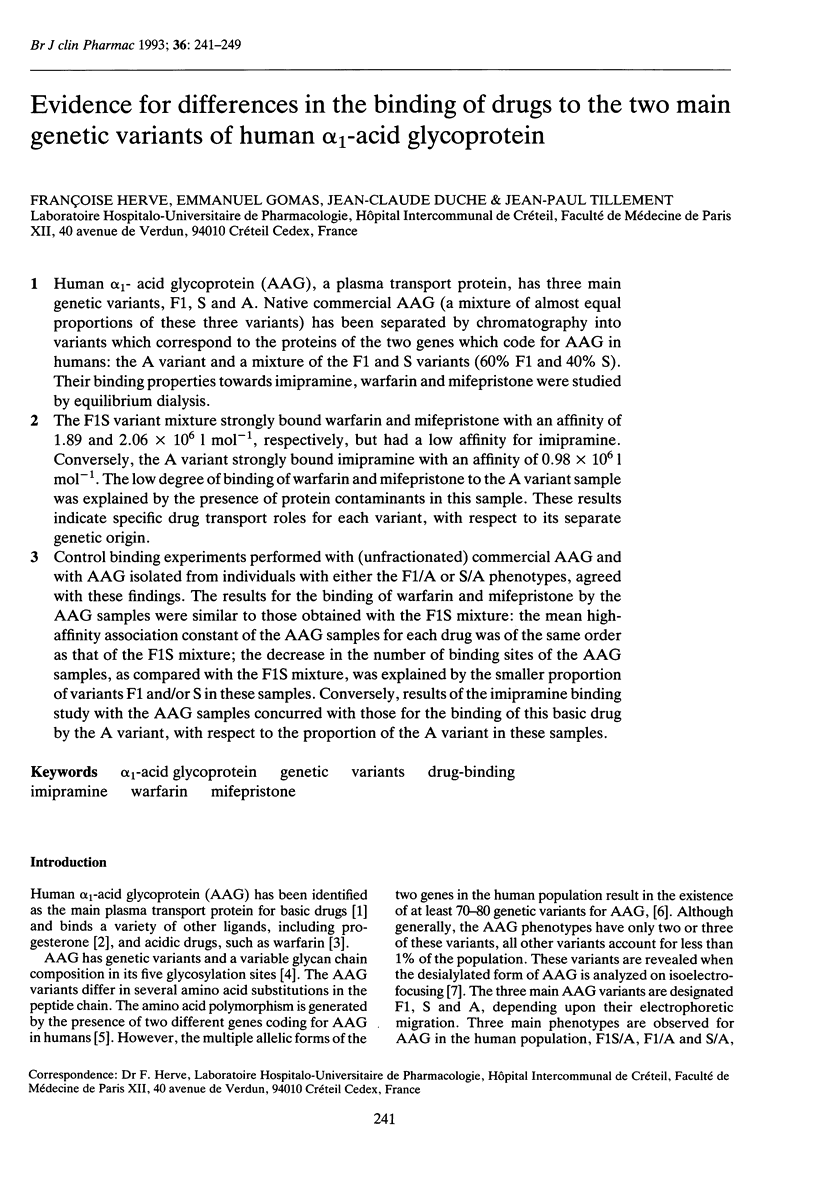
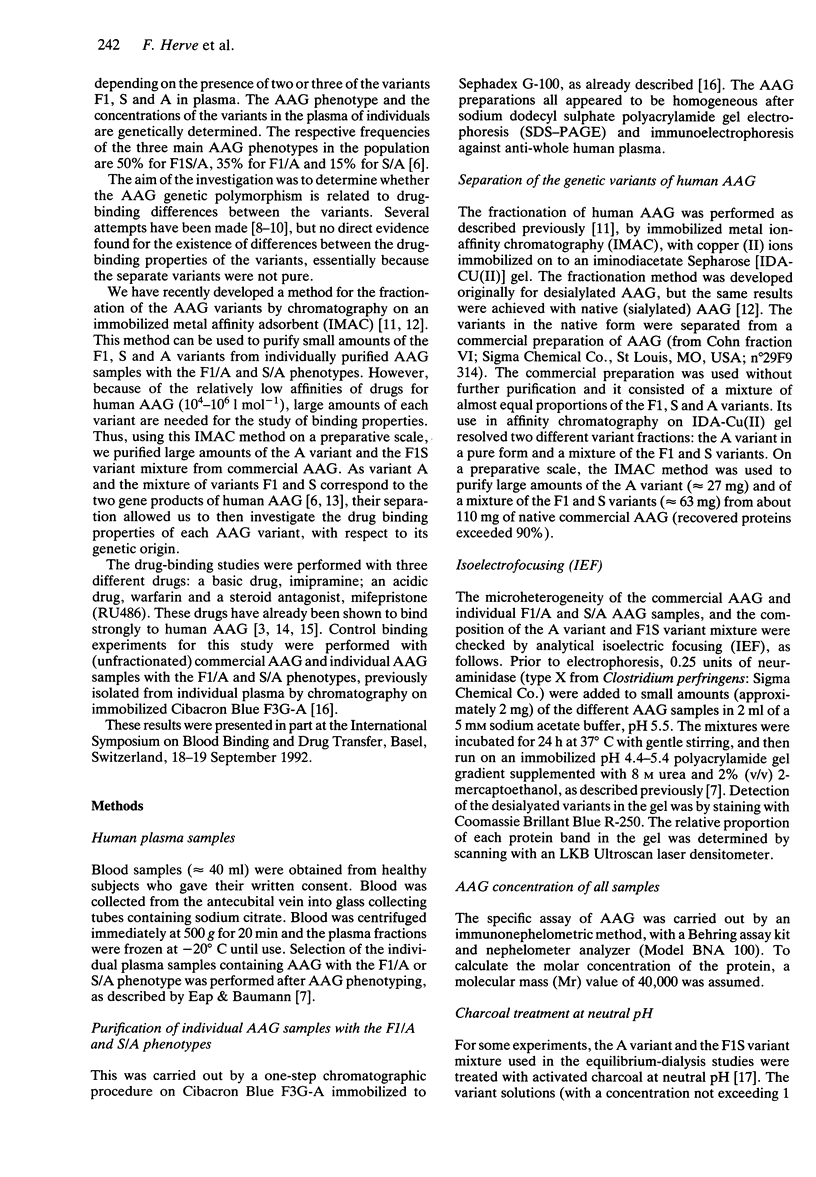
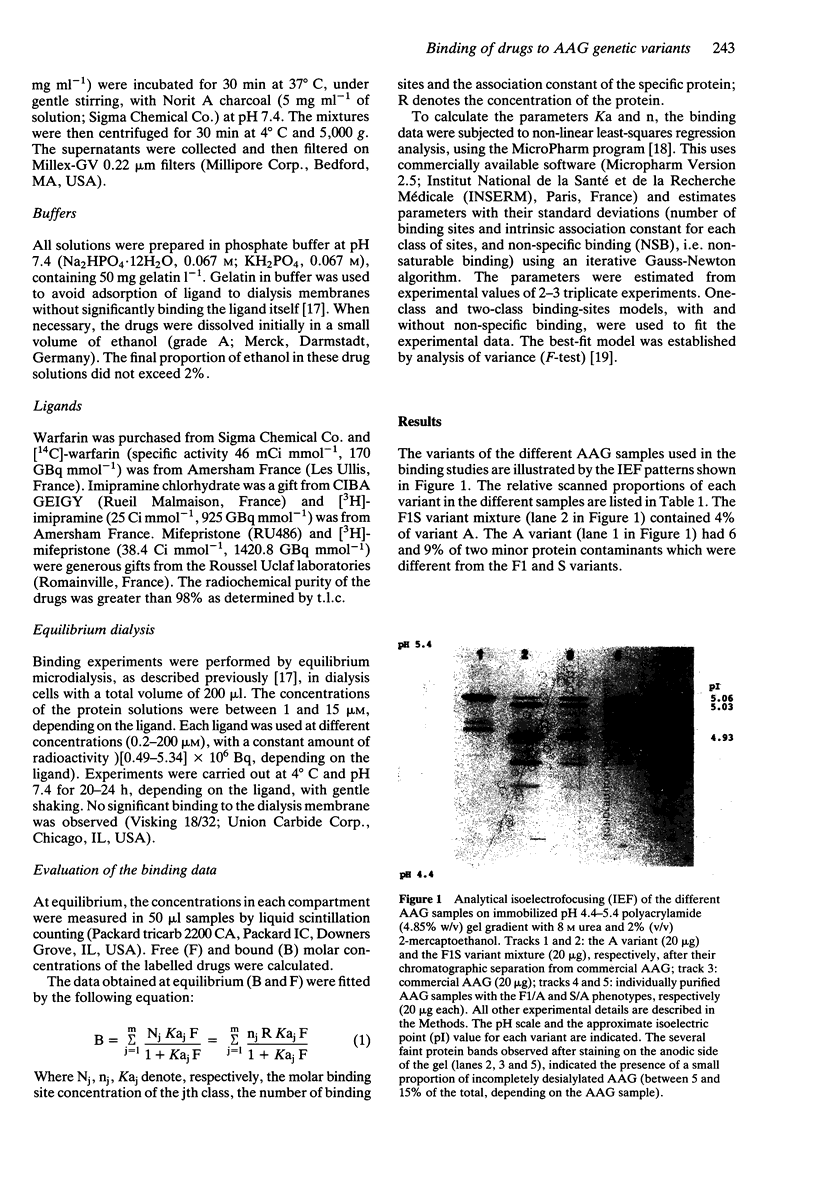
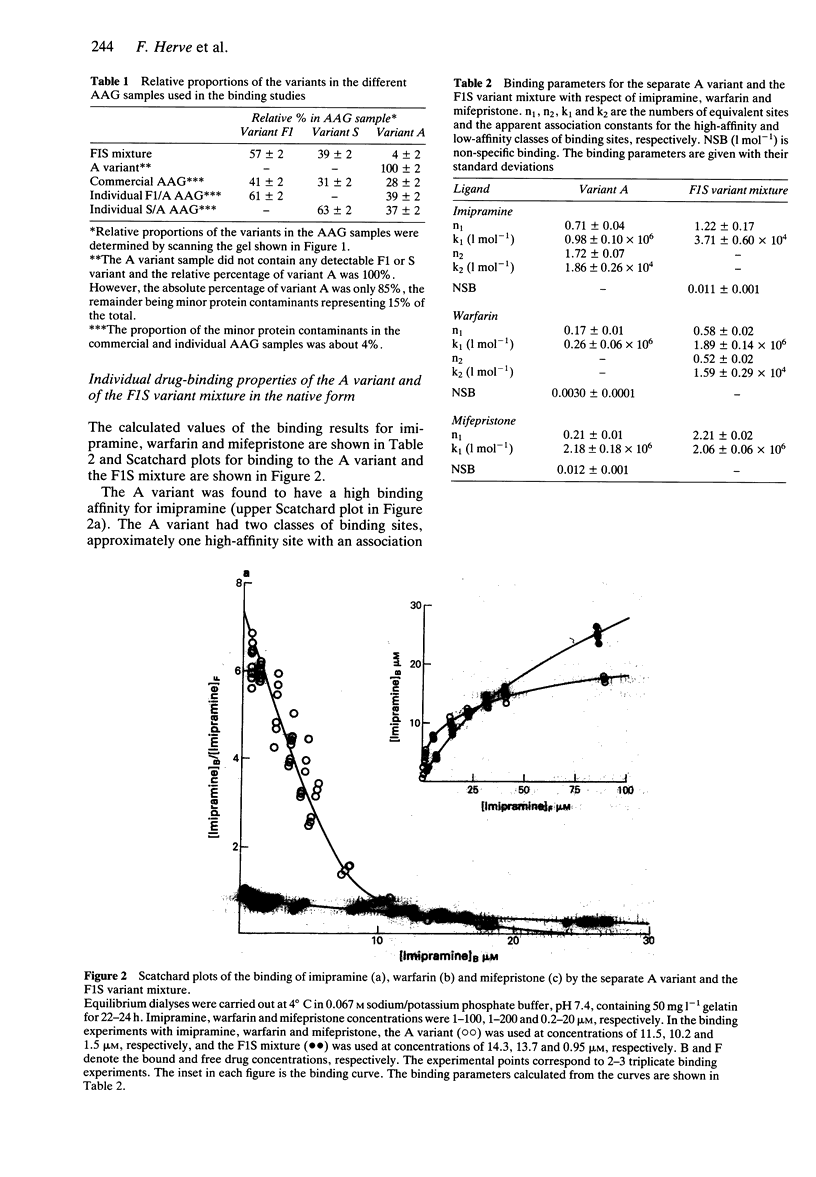
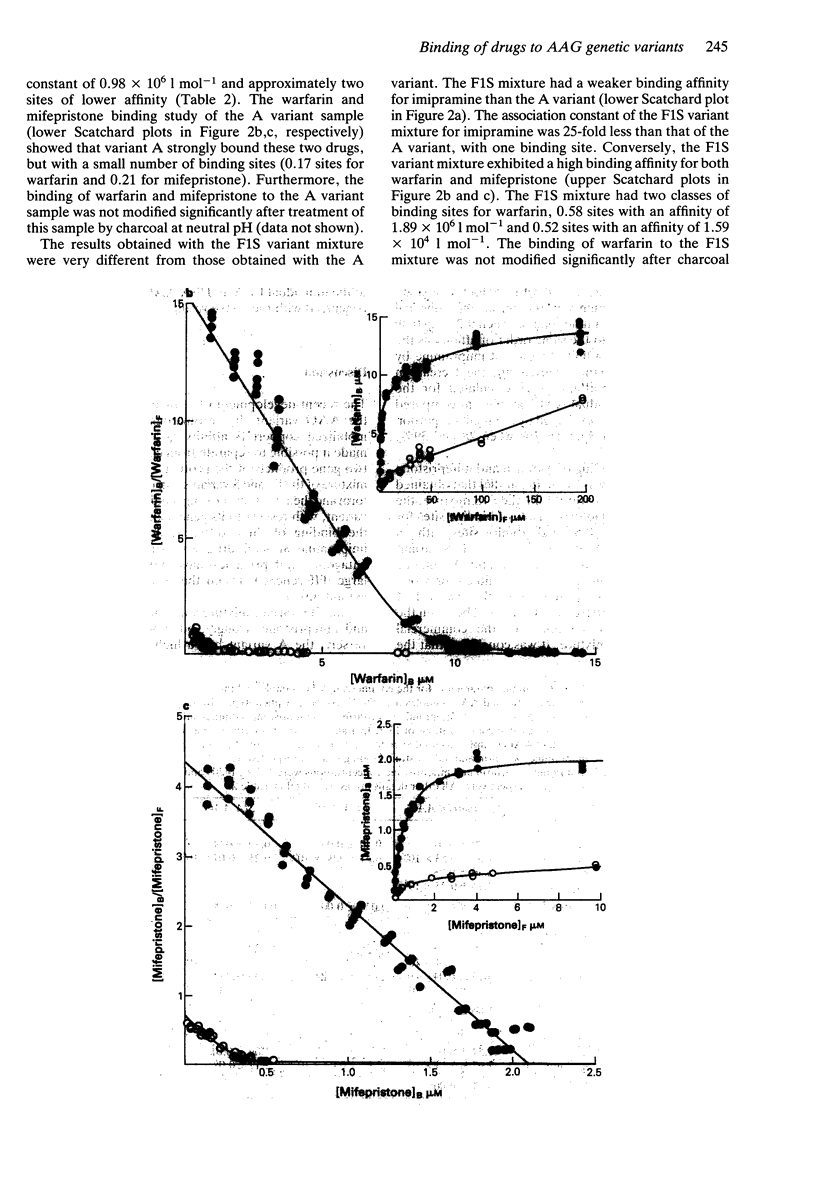
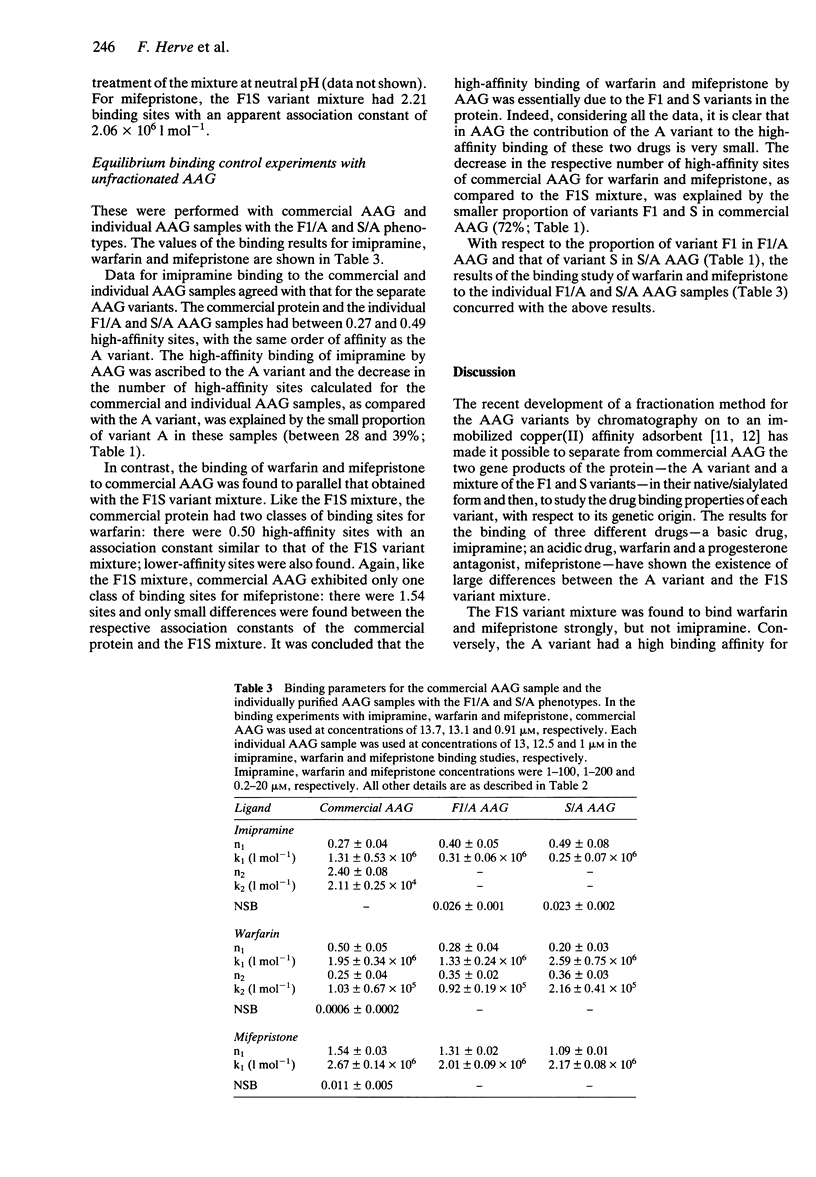
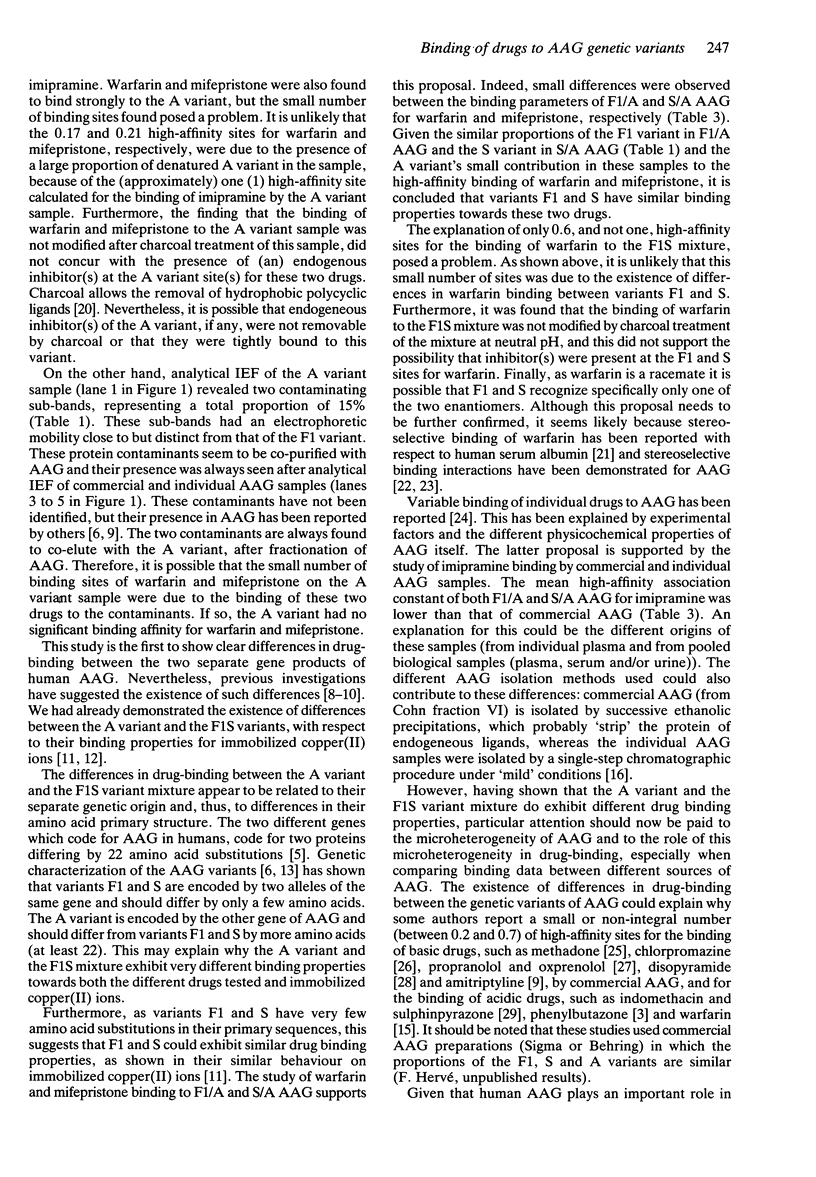

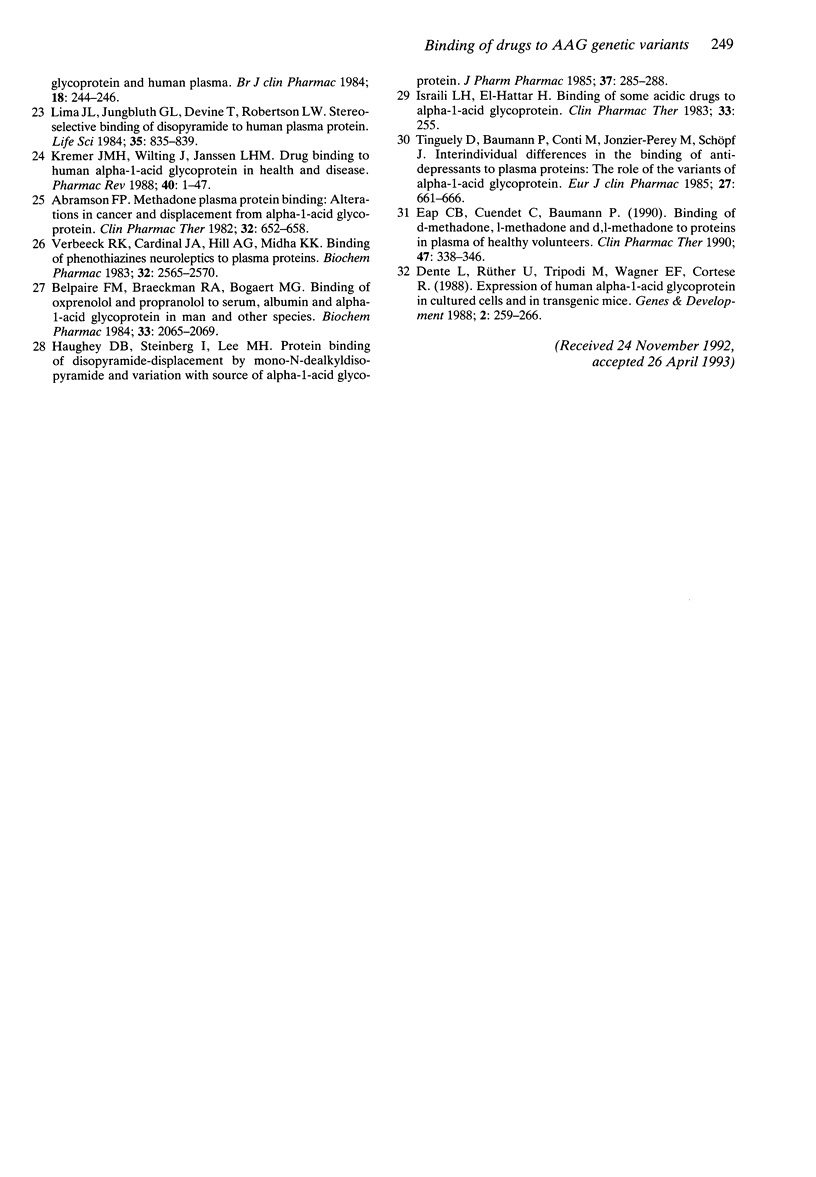
Images in this article
Selected References
These references are in PubMed. This may not be the complete list of references from this article.
- Abramson F. P. Methadone plasma protein binding: alterations in cancer and displacement from alpha 1-acid glycoprotein. Clin Pharmacol Ther. 1982 Nov;32(5):652–658. doi: 10.1038/clpt.1982.217. [DOI] [PubMed] [Google Scholar]
- Albani F., Riva R., Contin M., Baruzzi A. Stereoselective binding of propranolol enantiomers to human alpha 1-acid glycoprotein and human plasma. Br J Clin Pharmacol. 1984 Aug;18(2):244–246. doi: 10.1111/j.1365-2125.1984.tb02462.x. [DOI] [PMC free article] [PubMed] [Google Scholar]
- Belpaire F. M., Braeckman R. A., Bogaert M. G. Binding of oxprenolol and propranolol to serum, albumin and alpha 1-acid glycoprotein in man and other species. Biochem Pharmacol. 1984 Jul 1;33(13):2065–2069. doi: 10.1016/0006-2952(84)90575-6. [DOI] [PubMed] [Google Scholar]
- Bree F., Eap C. B., Baumann P., Duche J. C., Tillement J. P. Comparison of drug binding capacities of two AAG peptidic variants of human origin. Prog Clin Biol Res. 1989;300:399–403. [PubMed] [Google Scholar]
- Bree F., Rouzeau J. D., Durand G., Gardier A., Tillement J. P. Comparison of drug binding capacities of three AAG glycan variants of human origin. Prog Clin Biol Res. 1989;300:405–408. [PubMed] [Google Scholar]
- Chen R. F. Removal of fatty acids from serum albumin by charcoal treatment. J Biol Chem. 1967 Jan 25;242(2):173–181. [PubMed] [Google Scholar]
- Dente L., Pizza M. G., Metspalu A., Cortese R. Structure and expression of the genes coding for human alpha 1-acid glycoprotein. EMBO J. 1987 Aug;6(8):2289–2296. doi: 10.1002/j.1460-2075.1987.tb02503.x. [DOI] [PMC free article] [PubMed] [Google Scholar]
- Dente L., Rüther U., Tripodi M., Wagner E. F., Cortese R. Expression of human alpha 1-acid glycoprotein genes in cultured cells and in transgenic mice. Genes Dev. 1988 Feb;2(2):259–266. doi: 10.1101/gad.2.2.259. [DOI] [PubMed] [Google Scholar]
- Eap C. B., Baumann P. Isoelectric focusing of alpha-1 acid glycoprotein (orosomucoid) in immobilized pH-gradients with 8M urea: detection of its desialylated variants using an alkaline phosphatase-linked secondary antibody system. Electrophoresis. 1988 Oct;9(10):650–654. doi: 10.1002/elps.1150091005. [DOI] [PubMed] [Google Scholar]
- Eap C. B., Baumann P. The genetic polymorphism of human alpha 1-acid glycoprotein. Prog Clin Biol Res. 1989;300:111–125. [PubMed] [Google Scholar]
- Eap C. B., Cuendet C., Baumann P. Binding of amitriptyline to alpha 1-acid glycoprotein and its variants. J Pharm Pharmacol. 1988 Nov;40(11):767–770. doi: 10.1111/j.2042-7158.1988.tb05169.x. [DOI] [PubMed] [Google Scholar]
- Eap C. B., Cuendet C., Baumann P. Binding of d-methadone, l-methadone, and dl-methadone to proteins in plasma of healthy volunteers: role of the variants of alpha 1-acid glycoprotein. Clin Pharmacol Ther. 1990 Mar;47(3):338–346. doi: 10.1038/clpt.1990.37. [DOI] [PubMed] [Google Scholar]
- Eap C. B., Cuendet C., Baumann P. Selectivity in the binding of psychotropic drugs to the variants of alpha-1 acid glycoprotein. Naunyn Schmiedebergs Arch Pharmacol. 1988 Feb;337(2):220–224. doi: 10.1007/BF00169251. [DOI] [PubMed] [Google Scholar]
- Ganguly M., Carnighan R. H., Westphal U. Steroid-protein interactions. XIV. Interaction between human alpha 1-acid glycoprotein and progesterone. Biochemistry. 1967 Sep;6(9):2803–2814. doi: 10.1021/bi00861a022. [DOI] [PubMed] [Google Scholar]
- Haughey D. B., Steinberg I., Lee M. H. Protein binding of disopyramide--displacement by mono-N-dealkyldisopyramide and variation with source of alpha-1-acid glycoprotein. J Pharm Pharmacol. 1985 Apr;37(4):285–288. doi: 10.1111/j.2042-7158.1985.tb05066.x. [DOI] [PubMed] [Google Scholar]
- Herve F., Duche J. C., Sportes N., Tillement J. P. High-performance anion-exchange chromatographic study of desialylated human alpha 1-acid glycoprotein variants. Development of a fractionation method for the protein slow variants. J Chromatogr. 1991 Feb 22;539(2):405–416. doi: 10.1016/s0021-9673(01)83949-2. [DOI] [PubMed] [Google Scholar]
- Hervé F., Duché J. C., Barré J., Millot M. C., Tillement J. P. pH titration curves of the desialylated human alpha 1-acid glycoprotein variants by combined isoelectrofocusing-electrophoresis: utilization in the development of a fractionation method for the protein variants by chromatography on immobilized metal affinity adsorbent. J Chromatogr. 1992 May 20;577(1):43–59. doi: 10.1016/0378-4347(92)80597-j. [DOI] [PubMed] [Google Scholar]
- Hervé F., Gomas E., Duché J. C., Tillement J. P. Fractionation of the genetic variants of human alpha 1-acid glycoprotein in the native form by chromatography on an immobilized copper(II) affinity adsorbent. Heterogeneity of the separate variants by isoelectrofocusing and by concanavalin A affinity chromatography. J Chromatogr. 1993 May 19;615(1):47–57. [PubMed] [Google Scholar]
- Hervé F., Rajkowski K., Martin M. T., Dessen P., Cittanova N. Drug-binding properties of rat alpha 1-foetoprotein. Binding of warfarin, phenylbutazone, azapropazone, diazepam, digitoxin and cholic acid. Biochem J. 1984 Jul 15;221(2):401–406. doi: 10.1042/bj2210401. [DOI] [PMC free article] [PubMed] [Google Scholar]
- Kremer J. M., Wilting J., Janssen L. H. Drug binding to human alpha-1-acid glycoprotein in health and disease. Pharmacol Rev. 1988 Mar;40(1):1–47. [PubMed] [Google Scholar]
- Lima J. J., Jungbluth G. L., Devine T., Robertson L. W. Stereoselective binding of disopyramide to human plasma protein. Life Sci. 1984 Aug 20;35(8):835–839. doi: 10.1016/0024-3205(84)90408-9. [DOI] [PubMed] [Google Scholar]
- Routledge P. A. The plasma protein binding of basic drugs. Br J Clin Pharmacol. 1986 Nov;22(5):499–506. doi: 10.1111/j.1365-2125.1986.tb02927.x. [DOI] [PMC free article] [PubMed] [Google Scholar]
- Tinguely D., Baumann P., Conti M., Jonzier-Perey M., Schöpf J. Interindividual differences in the binding of antidepressives to plasma proteins: the role of the variants of alpha 1-acid glycoprotein. Eur J Clin Pharmacol. 1985;27(6):661–666. doi: 10.1007/BF00547045. [DOI] [PubMed] [Google Scholar]
- Tomei L., Eap C. B., Baumann P., Dente L. Use of transgenic mice for the characterization of human alpha 1-acid glycoprotein (orosomucoid) variants. Hum Genet. 1989 Dec;84(1):89–91. doi: 10.1007/BF00210681. [DOI] [PubMed] [Google Scholar]
- Urien S., Albengres E., Zini R., Tillement J. P. Evidence for binding of certain acidic drugs to alpha 1-acid glycoprotein. Biochem Pharmacol. 1982 Nov 15;31(22):3687–3689. doi: 10.1016/0006-2952(82)90597-4. [DOI] [PubMed] [Google Scholar]
- Urien S., Brée F., Testa B., Tillement J. P. pH-dependency of basic ligand binding to alpha 1-acid glycoprotein (orosomucoid). Biochem J. 1991 Nov 15;280(Pt 1):277–280. doi: 10.1042/bj2800277. [DOI] [PMC free article] [PubMed] [Google Scholar]
- Verbeeck R. K., Cardinal J. A., Hill A. G., Midha K. K. Binding of phenothiazine neuroleptics to plasma proteins. Biochem Pharmacol. 1983 Sep 1;32(17):2565–2570. doi: 10.1016/0006-2952(83)90019-9. [DOI] [PubMed] [Google Scholar]



